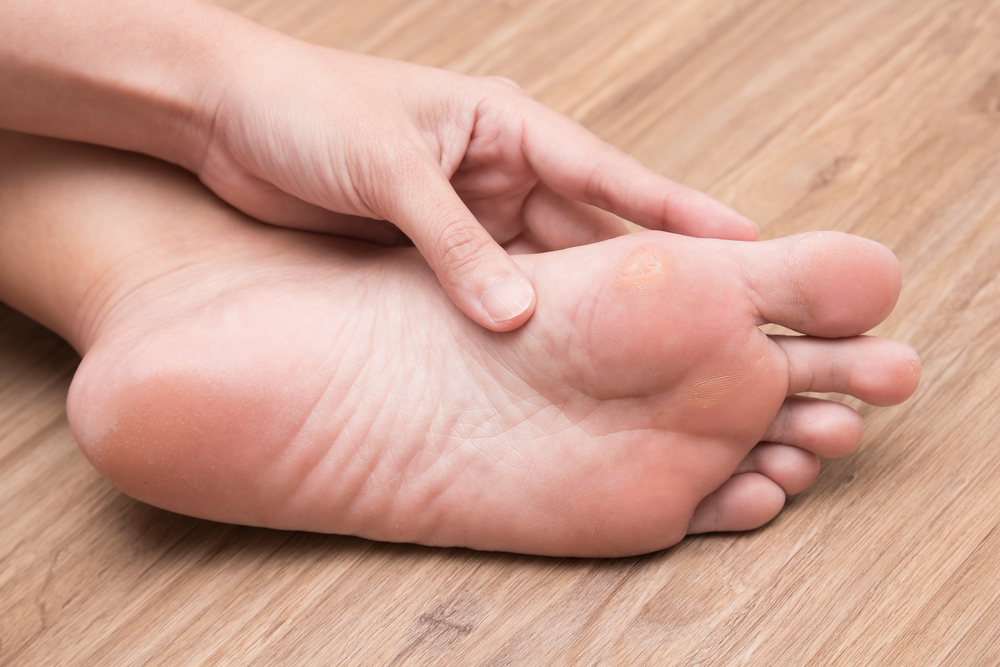Corn removal may be the last thing you want to think about, but it’s important to your overall health and well-being. It’s also relatively simple. The key is in finding the cause so you can adjust as necessary and get back to walking pain-free.
Is Corn Removal Permanent?
Podiatrists commonly treat corns with a small knife that trims away excess skin. But for permanent corn removal, the underlying cause(s) must be identified and addressed. Many different factors can lead to corns, so pinpointing your particular cause may require some investigation. Common contributors include:
- Shoes that are too tight or otherwise don’t fit properly
- Walking, standing, or running for extended periods
- Hobbies, activities, or work that apply pressure to the feet
- Regularly walking barefoot
- Wearing footwear without socks
- Wearing shoe linings or socks that bunch under your feet
- Walking heavily on your foot’s inner or outer edge
- Food deformities or altered biomechanics, including hammertoes
The common denominator here is always friction; corns develop when skin is repeatedly rubbed, irritated, or otherwise subjected to pressure. Hardened skin cells then accumulate as a way to protect underlying tissues from additional pressure. This explains why you commonly see corns on bony or prominent parts of the feet.
In-Office Treatment
Corn treatment usually begins with a physical examination of your foot. Imaging studies such as an MRI or X-ray may also be used to paint a broader picture of your foot and identify deformities. If deformities or other concerns are visible in the imaging studies, surgery may be recommended. This depends on the severity of the concern and the impact it’s having on your feet.
As mentioned earlier, the corn can be trimmed and then treated with a pad to improve comfort. If abnormal weight distribution is responsible for the corn formation, a custom orthotic may be prescribed to reduce pressure across the balls of your feet. Orthotics can also control abnormal foot motion and improve foot cushioning.
Steps You Can Take
It’s important to explore what you can do at home to aid corn treatment. We may, for instance, recommend you wear more supportive shoes; this is key for all patients, including those who are diabetic, suffering from neuropathy, and women who frequently wear high heels. Although attractive to look at, these shoes place your feet in unnatural positions. Even after the corn is cut away, it’s likely to return if you continue wearing heels.
This isn’t to say you must completely give up your favorite shoes. Instead, you can improve foot health by wearing comfortable shoes anytime you’re out of heels; this includes donning a pair of sneakers or supportive slip-ons to and from work. Also, lower the height of your heels and/or opt for wedges to reduce pressure. You can additionally wear open shoes to give your toes more room and place a quality insert directly into each shoe.
Only Follow Recommendations
Although touted as indispensable cure-alls, most home remedies can cause additional injury to your foot. For instance, corn plasters purchased from a local store can burn and blister surrounding tissues. You should also leave corn trimming to a trained medical professional; attempting this at home can lead to an increased risk of infection and permanently damage nerves and blood vessels.
The recommendations we make after your office visit, however, should be followed. These might include applying cold compresses to ease pain and frequently rubbing lotion into your feet to keep skin soft. Such suggestions will complement, rather than hinder, treatment and enable you to walk with greater ease.
If Left Untreated
You may be tempted to just live with your corns, but you should know they won’t disappear without treatment. A podiatrist can also determine the underlying cause, as mentioned earlier, even if it’s nothing more complex than changing the shoes you wear.
Until you eliminate the source of friction, corns will continue to grow thicker and more painful. They can eventually press on underlying nerves and make walking all but impossible. At a certain point, your body will treat the corn as a foreign object, and when this happens, ulcers can develop. Ulcers pose serious complications for patients with poor circulation or diabetes.
What Are Corns?
Many people use the words corns and calluses interchangeably, but they’re two different conditions. Corns can best be described as small and round and often afflict the side or tops of your toes. Additionally, corns can be categorized in one of three ways:
- Hard corns, characterized by small, hard patches usually located within a larger area of thickened skin
- Soft corns, which tend to develop between the toes, range in color from white to gray, and feel soft and rubbery
- Seed corns, usually found on the bottom of feet
Calluses, on the other hand, appear larger in size and more irregular in shape. These regularly form on foot areas that bear the most weight, including the big toe, heel, and ball of the foot. Most health care providers agree that some callus formation on the foot is normal. These patches can also be found on the hands, such as the fingers of craftsmen or pads of weightlifters.
Those at Greatest Risk
We already mentioned you’re likely to develop corns if you walk barefoot or have a condition that changes the normal alignment of your foot bones. You’re also at risk if you wear shoes too narrow for your foot or smoke. That’s right – cigarettes can impede blood flow to your feet. And the blood they do receive is oxygen-deprived, meaning skin cells will lack the nutrients they need to properly renew and exfoliate.
A genetic skin disorder known as palmoplantar keratosis can also contribute to corns. With this pathology, the skin thickens for no apparent reason in areas of high pressure, such as the feet and hands. Corns therefore develop more easily.
Preventing Corns
If you’re like most people, you overlook your feet until a problem develops. Giving these appendages the care they deserve, however, can help prevent corns. We recommend you start by wearing shoes that fit well. A study published in the Postgraduate Medical Journal confirms 65% of men and 77% of women wear ill-fitting shoes every day. The best qualities to look for in footwear include:
- Shock-absorbing soles
- Wide toe areas
- Soft cushioning
- The support you need for daily activities
A Few More Suggestions
In addition, you should wear socks with all footwear (except sandals). These garments prevent unnecessary rubbing between bare skin and shoe materials. While any sock is better than none, you should look for those that fit snug enough to prevent bunching under your feet.
Placing lamb’s wool, not cotton, between toes can relieve friction, and properly washing, drying, and moisturizing feet every day keeps skin supple. You should also keep toenails trimmed – cut straight across without rounding the corners – and apply a daily foot powder to keep skin free of sweat.
Corns aren’t necessarily dangerous, but they do require attention. We’re not talking about the kind you give yourself, wherein you attempt at-home corn removal with a knife or over-the-counter acidic solution. Instead, you should let a podiatrist perform an examination, trim away excess skin, and identify the underlying cause for lasting relief. You can begin this process today by calling the professional team at Island Foot Clinics.

